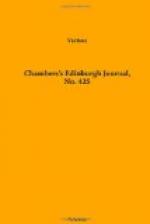’It was the seventeenth
day of May, in the year ’ninety-six,
Our taut frigate
the Ajax, she from Plymouth did set sail;
Eight days out, com’d
a squall from north-east by north,
And then by four
bells, morning-watch, it did freshen to a gale.’
Perhaps the most universally popular song among seamen is Rule Britannia; but in general they do little more than sing the chorus, and the way in which a crew of tars, when half-seas-over, will monotonously drawl out ’Britons never, never, never shall be slaves!’—repeating it over and over again, as if they never could have too much of a good thing—is highly amusing. We believe that a decided majority of the songs sang in the forecastle are not sea-songs at all, but purely land-songs; and, strange to say, the most popular of these are sentimental ditties, such as were, a score of years ago, drawing-room favourites! It is very rich to hear ‘ancient marineres,’ rough as bears, hoarsely quavering, I’d be a butterfly! or, O no! we never mention her; or, The days we went a-gipsying, long time ago! They are also very partial to songs about bandits and robbers.
Well, after all, we have often, when in a tight craft, tossing amid howling billows, complacently repeated—and perchance shall again—the closing lines of The Sailor’s Consolation, which, we believe, but are not certain, Dibdin wrote—
’Then, Bill, let us
thank Providence
That
you and I are sailors!’
FOOTNOTES:
[4] See The ‘Romance’ of Sea-Life, No. 414 of the Journal.
[5] We must explain that the working-songs of seamen—or such as they sing when heaving at the pawl-windlass, catting the anchor, and other heavy pieces of work—are of a different class altogether, and consist chiefly of a variety of appropriate choruses to lively and inspiriting tunes. These songs sound well, and are worth anything on shipboard, for they stimulate the men far more than grog would do with only a dead, silent heave or haul.
‘SEWED MUSLINS.’
Under the above technical name is produced in Glasgow a manufacture little known beyond the sphere of those immediately engaged in the business, the importance of which, however, as a means of employment to the poorer Scotch and Irish peasantry, renders it deserving of more attention than it has hitherto received. Sewed muslins include all those articles which are composed of muslin with a pattern embroidered on it by the hand—such as collars, sleeves, chemisettes, &c. together with the long strips of embroidery used, like laces, for trimming dresses, petticoats, &c. and called, technically, trimmings. The manufacture of these articles in the form in which they are now used was for a long period peculiar to France, and that country alone supplied all the rest of the world with the limited quantities which the high cost permitted




